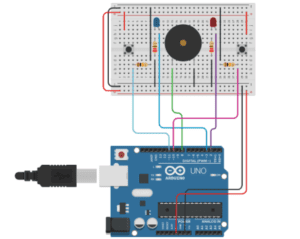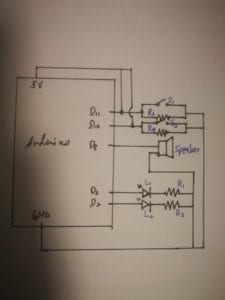Exercises
Circuit 1: Fade

This circuit is programmed to light and dim the LED repeatingly in a certain pace. Since the circuit is simple, me and my partner succeeded in building it very quickly without difficulty.
Circuit 2: tone Melody

The second circuit is also easy to build. It sets off a speaker to play a record of music. We also finished it very soon.
Circuit 3: Speed Game
 Physical sketch map
Physical sketch map
The third circuit, however, is far more complicated that the former two, so it took most of our time in the recitation class to build and correct this one. The circuit is a gameboard where two players compete to reach ten hits on their buttons: The LED on the winner’s side will light up.
 Self-drawn Diagram
Self-drawn Diagram
We met mainly two problems during our building process. When we finished the first try of building and began to test it, we found that player 2’s data of pushing the button was not recorded by the monitor. We modified the positions of some wires to see more clearly where had gone wrong, but we did not find any problem in the part of player 2’s circuit. Taking the advice of the faculty, we changed some parts of the circuit to see if they were functioning properly. Finally, we found the button for player 2 malfunctioning.
After fixing the problem of the failing button, we tested again, only to notice another problem: Player 1’s LED did not light up even if player 1 wins. We troubleshot the circuit again with the help of the faculty, we found that the signal of LED 1 did not go back to the arduino but went to the Groud on the breadboard.
Having fixed these problems, we finally made our speed game work perfectly.
Questions
Question 1:
Reflect how you use technology in your daily life and on the circuits you just built. Use the text Physical Computing and your own observations to define interaction.
The most representitive use of technology in my daily life must be the cellphone, namely the communication apps. I think one biggest different of communication apps (for example, wechat) and traditional communication methods (like letters and phone calls) lies in their ability to achieve information delivery and storing immediately. Since the chatting apps deliver the message from user A to user B instantly, they do not force user B to receive and reply. Instead, they allow delayed responds because they can store the message information as chatting records. This feature of technology attaches freedom to the user (me), thus improves my experience in communicating with others. This feeling of mine is contexualized by the definition of interaction given by Igoe and O’sullivan’s article, that computers, as a tool, are meant to store and process information in order to aid human expressions.
Question 2:
If you have 100,000 LEDs of any brightness and color at your disposal, what would you make and where would you put it?
I want to build a Harry Potter theme park with lots of magic experience spaces. For example, the LEDs will light up to form various magical beam patterns catering to the participants’ actions (like waving the wand) and words (spells) captured by sensors. I would like to put it in a vacation resort of a megacity.